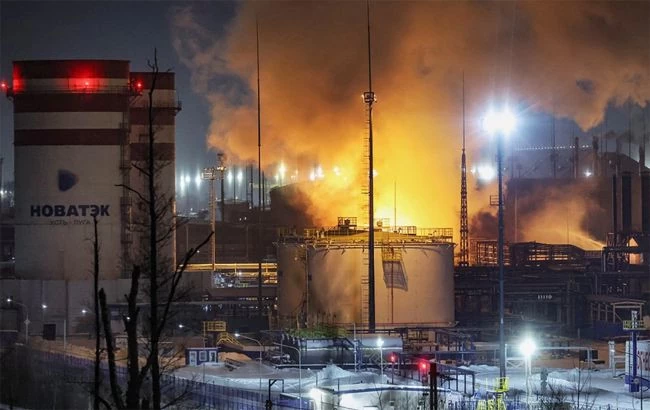Multinational forces in Ukraine: Europe’s antidote to fear
global.espreso.tv
Wed, 10 Sep 2025 13:31:00 +0300

Contents1. Organizing and operating a military contingent in Ukraine2. Joint Expeditionary Force: model for Ukraine’s military contingent3. From Joint Expeditionary Force to Multinational Forces: why Europe needs itUndoubtedly, the presence of a European military component in Ukraine still seems like a “parallel reality,” since any “security guarantees” or other practical steps by the countries of the coalition are only possible after a ceasefire. However, the very fact that European countries are consolidating around the idea of forming an armed contingent on Ukrainian territory to prevent new Russian aggression represents significant progress.Last week in Paris, important decisions were made which, due to their “parallel” nature alongside the massive strikes of Russian Shahed drones and missiles on Ukrainian cities, had little impact on the information space. Nevertheless, the Coalition of the Willing has in fact begun practical steps toward forming military structures for deployment on Ukrainian territory.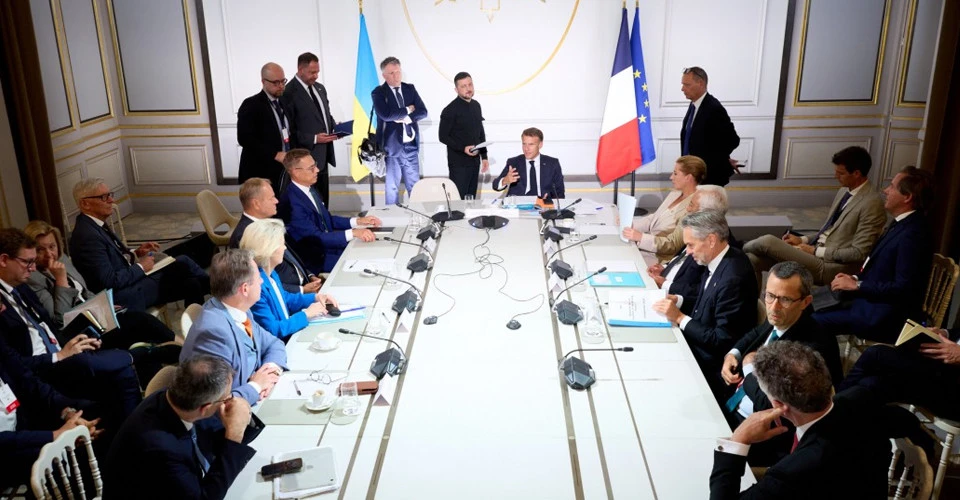 Paris meeting of the Coalition of the Willing, photo: president.gov.uaOrganizing and operating a military contingent in UkraineFollowing the Paris meeting of the Coalition of the Willing, it was reported that 26 countries are prepared to deploy their troops to participate in a mission in Ukraine after a ceasefire, with an estimated contingent of 25,000–30,000 personnel. The United States has pledged strategic support in intelligence, communications, and air support, while Turkey may contribute to security efforts in the Black Sea.More details later emerged. The UK Ministry of Defence announced that the European military contingent on Ukrainian territory will be called the Multinational Force Ukraine (MNF-U), and the MNF-U headquarters in Kyiv will be led by a two-star British Army general. France and the United Kingdom will jointly provide strategic command of the MNF-U at the three-star general level. Furthermore, in response to UK Conservative MP James Cartlidge, UK Defence Secretary Luke Pollard confirmed that the MNF-U headquarters commander has already been appointed, but for security reasons, this information is not currently public.Regarding broader commitments to the MNF-U, the UK minister stated that the Ministry of Defence keeps forces from all branches of the Armed Forces on standby for a wide range of contingencies and operations, including MNF-U, but for now, details about these forces cannot be disclosed.
Paris meeting of the Coalition of the Willing, photo: president.gov.uaOrganizing and operating a military contingent in UkraineFollowing the Paris meeting of the Coalition of the Willing, it was reported that 26 countries are prepared to deploy their troops to participate in a mission in Ukraine after a ceasefire, with an estimated contingent of 25,000–30,000 personnel. The United States has pledged strategic support in intelligence, communications, and air support, while Turkey may contribute to security efforts in the Black Sea.More details later emerged. The UK Ministry of Defence announced that the European military contingent on Ukrainian territory will be called the Multinational Force Ukraine (MNF-U), and the MNF-U headquarters in Kyiv will be led by a two-star British Army general. France and the United Kingdom will jointly provide strategic command of the MNF-U at the three-star general level. Furthermore, in response to UK Conservative MP James Cartlidge, UK Defence Secretary Luke Pollard confirmed that the MNF-U headquarters commander has already been appointed, but for security reasons, this information is not currently public.Regarding broader commitments to the MNF-U, the UK minister stated that the Ministry of Defence keeps forces from all branches of the Armed Forces on standby for a wide range of contingencies and operations, including MNF-U, but for now, details about these forces cannot be disclosed.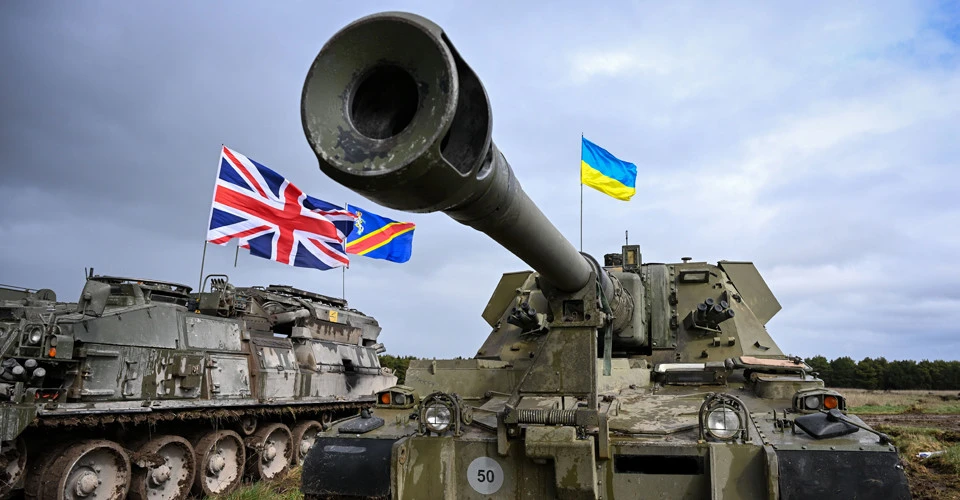 Ukrainian servicemen conduct live-fire exercises at a British Army training range, photo: Getty ImagesLuke Pollard clarified that the joint MNF-U command format (France–UK) is expected to be maintained throughout the entire mission in Ukraine, regardless of whether the main headquarters is located in London or Paris.Since participation in the MNF-U is expected to involve around 30 countries, a central issue for the contingent’s command is ensuring interoperability in planning, command, and force deployment. It is currently known that the main working language of the MNF-U headquarters will be English, in line with NATO protocols.Joint Expeditionary Force: model for Ukraine’s military contingentThe leadership of the United Kingdom and France in creating a military contingent within the Coalition of the Willing is explained not only by the political interests of the French and British leadership but also by the fact that, back in 2010, under a bilateral agreement (The Lancaster House Treaties), London and Paris committed to establishing the Combined Joint Expeditionary Force (CJEF). The purpose of creating the CJEF was to form a joint military grouping with land, air, and naval components, as well as command and control elements and logistical support. The CJEF was conceived as a deployable UK–France joint military formation capable of operating across a wide range of crisis scenarios, including high-intensity operations. As a combined force, it encompasses all three branches of the armed forces: a land component formed at the national brigade level, naval and air components with corresponding headquarters, as well as logistics and support functions. According to the bilateral agreement, the CJEF is not a permanent formation; instead, it can be rapidly deployed for UK–France operations or as part of NATO, EU, UN, or other missions. Since its creation, the CJEF has progressed toward operational readiness, which was achieved in 2016 with the gradual establishment of its land, air, and naval components. Currently, the CJEF includes command elements at the strategic, operational, and tactical levels, as well as deployable naval, land, air, and logistical components from both France and the UK. It also has the capacity to incorporate other states as coalition partners. Notably, this forms one of the key aspects of establishing a military contingent for deployment on Ukrainian territory.
Ukrainian servicemen conduct live-fire exercises at a British Army training range, photo: Getty ImagesLuke Pollard clarified that the joint MNF-U command format (France–UK) is expected to be maintained throughout the entire mission in Ukraine, regardless of whether the main headquarters is located in London or Paris.Since participation in the MNF-U is expected to involve around 30 countries, a central issue for the contingent’s command is ensuring interoperability in planning, command, and force deployment. It is currently known that the main working language of the MNF-U headquarters will be English, in line with NATO protocols.Joint Expeditionary Force: model for Ukraine’s military contingentThe leadership of the United Kingdom and France in creating a military contingent within the Coalition of the Willing is explained not only by the political interests of the French and British leadership but also by the fact that, back in 2010, under a bilateral agreement (The Lancaster House Treaties), London and Paris committed to establishing the Combined Joint Expeditionary Force (CJEF). The purpose of creating the CJEF was to form a joint military grouping with land, air, and naval components, as well as command and control elements and logistical support. The CJEF was conceived as a deployable UK–France joint military formation capable of operating across a wide range of crisis scenarios, including high-intensity operations. As a combined force, it encompasses all three branches of the armed forces: a land component formed at the national brigade level, naval and air components with corresponding headquarters, as well as logistics and support functions. According to the bilateral agreement, the CJEF is not a permanent formation; instead, it can be rapidly deployed for UK–France operations or as part of NATO, EU, UN, or other missions. Since its creation, the CJEF has progressed toward operational readiness, which was achieved in 2016 with the gradual establishment of its land, air, and naval components. Currently, the CJEF includes command elements at the strategic, operational, and tactical levels, as well as deployable naval, land, air, and logistical components from both France and the UK. It also has the capacity to incorporate other states as coalition partners. Notably, this forms one of the key aspects of establishing a military contingent for deployment on Ukrainian territory.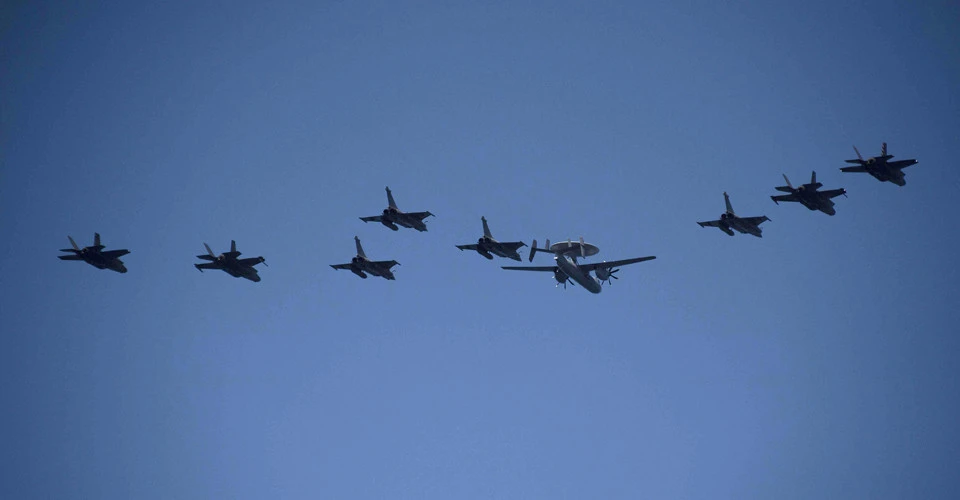 French and British fighter jets during the Gallic Strike exercises, photo: Getty ImagesFrom Joint Expeditionary Force to Multinational Forces: why Europe needs itThe Franco-British Combined Joint Expeditionary Force, as we can see, is a fully acceptable, if not ideal, framework for establishing the Multinational Force Ukraine. Its command system, land, air, and naval components, together with comprehensive logistical support, provide exactly what is needed for the rapid realization of the idea of forming European forces in Ukraine. The ability to respond quickly to situations, conduct autonomous operations, and operate without direct integration into national military-political decision-making systems turns the CJEF model into a functional core of the MNF-U. The next step is to integrate national contingents from the Coalition of the Willing into the current structure, distributing them across the various components (land, air, naval, logistical), and the European grouping for “post-war security guarantees for Ukraine” will be ready.In practice, if implemented, the creation of the MNF-U could become the largest European military operation at least since the 1990s, when Europe conducted peacekeeping operations in the Balkans, and it will require a concentration of European political and military efforts. The paradox is that the main challenge for Europeans will not be military standards or interoperability, but the willingness to overcome the fear of the myth of “Russian invincibility.” Even the deployment of forces in Ukraine after a ceasefire still provokes an unnatural fear in a significant number of EU countries. Practical steps to establish the Multinational Force Ukraine could serve as a kind of “remedy for fear” for Europeans, who, by observing the Ukrainians, will finally grasp the urgent need to dismantle an aggressive empire that will not stop until it gains control over all of Europe.
French and British fighter jets during the Gallic Strike exercises, photo: Getty ImagesFrom Joint Expeditionary Force to Multinational Forces: why Europe needs itThe Franco-British Combined Joint Expeditionary Force, as we can see, is a fully acceptable, if not ideal, framework for establishing the Multinational Force Ukraine. Its command system, land, air, and naval components, together with comprehensive logistical support, provide exactly what is needed for the rapid realization of the idea of forming European forces in Ukraine. The ability to respond quickly to situations, conduct autonomous operations, and operate without direct integration into national military-political decision-making systems turns the CJEF model into a functional core of the MNF-U. The next step is to integrate national contingents from the Coalition of the Willing into the current structure, distributing them across the various components (land, air, naval, logistical), and the European grouping for “post-war security guarantees for Ukraine” will be ready.In practice, if implemented, the creation of the MNF-U could become the largest European military operation at least since the 1990s, when Europe conducted peacekeeping operations in the Balkans, and it will require a concentration of European political and military efforts. The paradox is that the main challenge for Europeans will not be military standards or interoperability, but the willingness to overcome the fear of the myth of “Russian invincibility.” Even the deployment of forces in Ukraine after a ceasefire still provokes an unnatural fear in a significant number of EU countries. Practical steps to establish the Multinational Force Ukraine could serve as a kind of “remedy for fear” for Europeans, who, by observing the Ukrainians, will finally grasp the urgent need to dismantle an aggressive empire that will not stop until it gains control over all of Europe.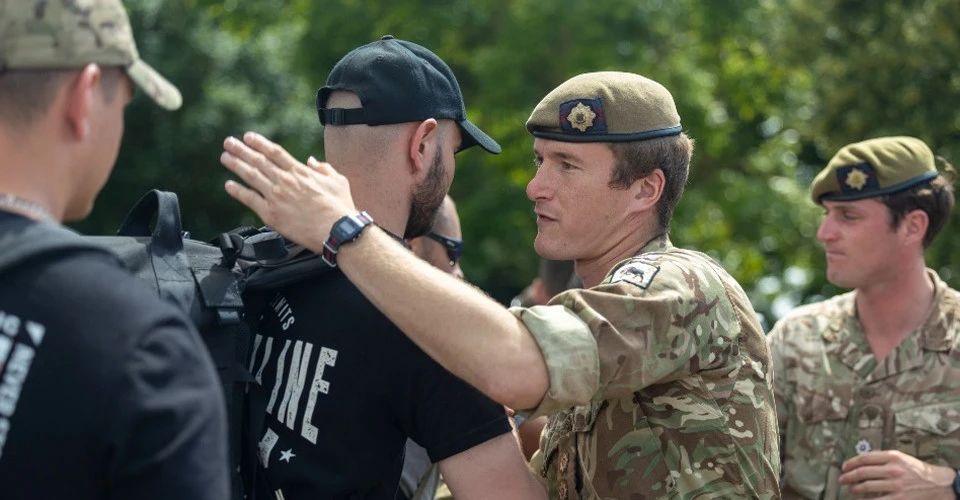 Ukrainian and British military personnel, photo: gov.ukThis material was prepared in cooperation with the Consortium for Defense Information (CDI), a project that unites Ukrainian analytical and research organizations and is aimed at strengthening information support and analytical capacity in the fields of national security, defense, and geopolitics.
Ukrainian and British military personnel, photo: gov.ukThis material was prepared in cooperation with the Consortium for Defense Information (CDI), a project that unites Ukrainian analytical and research organizations and is aimed at strengthening information support and analytical capacity in the fields of national security, defense, and geopolitics.
 Paris meeting of the Coalition of the Willing, photo: president.gov.uaOrganizing and operating a military contingent in UkraineFollowing the Paris meeting of the Coalition of the Willing, it was reported that 26 countries are prepared to deploy their troops to participate in a mission in Ukraine after a ceasefire, with an estimated contingent of 25,000–30,000 personnel. The United States has pledged strategic support in intelligence, communications, and air support, while Turkey may contribute to security efforts in the Black Sea.More details later emerged. The UK Ministry of Defence announced that the European military contingent on Ukrainian territory will be called the Multinational Force Ukraine (MNF-U), and the MNF-U headquarters in Kyiv will be led by a two-star British Army general. France and the United Kingdom will jointly provide strategic command of the MNF-U at the three-star general level. Furthermore, in response to UK Conservative MP James Cartlidge, UK Defence Secretary Luke Pollard confirmed that the MNF-U headquarters commander has already been appointed, but for security reasons, this information is not currently public.Regarding broader commitments to the MNF-U, the UK minister stated that the Ministry of Defence keeps forces from all branches of the Armed Forces on standby for a wide range of contingencies and operations, including MNF-U, but for now, details about these forces cannot be disclosed.
Paris meeting of the Coalition of the Willing, photo: president.gov.uaOrganizing and operating a military contingent in UkraineFollowing the Paris meeting of the Coalition of the Willing, it was reported that 26 countries are prepared to deploy their troops to participate in a mission in Ukraine after a ceasefire, with an estimated contingent of 25,000–30,000 personnel. The United States has pledged strategic support in intelligence, communications, and air support, while Turkey may contribute to security efforts in the Black Sea.More details later emerged. The UK Ministry of Defence announced that the European military contingent on Ukrainian territory will be called the Multinational Force Ukraine (MNF-U), and the MNF-U headquarters in Kyiv will be led by a two-star British Army general. France and the United Kingdom will jointly provide strategic command of the MNF-U at the three-star general level. Furthermore, in response to UK Conservative MP James Cartlidge, UK Defence Secretary Luke Pollard confirmed that the MNF-U headquarters commander has already been appointed, but for security reasons, this information is not currently public.Regarding broader commitments to the MNF-U, the UK minister stated that the Ministry of Defence keeps forces from all branches of the Armed Forces on standby for a wide range of contingencies and operations, including MNF-U, but for now, details about these forces cannot be disclosed. Ukrainian servicemen conduct live-fire exercises at a British Army training range, photo: Getty ImagesLuke Pollard clarified that the joint MNF-U command format (France–UK) is expected to be maintained throughout the entire mission in Ukraine, regardless of whether the main headquarters is located in London or Paris.Since participation in the MNF-U is expected to involve around 30 countries, a central issue for the contingent’s command is ensuring interoperability in planning, command, and force deployment. It is currently known that the main working language of the MNF-U headquarters will be English, in line with NATO protocols.Joint Expeditionary Force: model for Ukraine’s military contingentThe leadership of the United Kingdom and France in creating a military contingent within the Coalition of the Willing is explained not only by the political interests of the French and British leadership but also by the fact that, back in 2010, under a bilateral agreement (The Lancaster House Treaties), London and Paris committed to establishing the Combined Joint Expeditionary Force (CJEF). The purpose of creating the CJEF was to form a joint military grouping with land, air, and naval components, as well as command and control elements and logistical support. The CJEF was conceived as a deployable UK–France joint military formation capable of operating across a wide range of crisis scenarios, including high-intensity operations. As a combined force, it encompasses all three branches of the armed forces: a land component formed at the national brigade level, naval and air components with corresponding headquarters, as well as logistics and support functions. According to the bilateral agreement, the CJEF is not a permanent formation; instead, it can be rapidly deployed for UK–France operations or as part of NATO, EU, UN, or other missions. Since its creation, the CJEF has progressed toward operational readiness, which was achieved in 2016 with the gradual establishment of its land, air, and naval components. Currently, the CJEF includes command elements at the strategic, operational, and tactical levels, as well as deployable naval, land, air, and logistical components from both France and the UK. It also has the capacity to incorporate other states as coalition partners. Notably, this forms one of the key aspects of establishing a military contingent for deployment on Ukrainian territory.
Ukrainian servicemen conduct live-fire exercises at a British Army training range, photo: Getty ImagesLuke Pollard clarified that the joint MNF-U command format (France–UK) is expected to be maintained throughout the entire mission in Ukraine, regardless of whether the main headquarters is located in London or Paris.Since participation in the MNF-U is expected to involve around 30 countries, a central issue for the contingent’s command is ensuring interoperability in planning, command, and force deployment. It is currently known that the main working language of the MNF-U headquarters will be English, in line with NATO protocols.Joint Expeditionary Force: model for Ukraine’s military contingentThe leadership of the United Kingdom and France in creating a military contingent within the Coalition of the Willing is explained not only by the political interests of the French and British leadership but also by the fact that, back in 2010, under a bilateral agreement (The Lancaster House Treaties), London and Paris committed to establishing the Combined Joint Expeditionary Force (CJEF). The purpose of creating the CJEF was to form a joint military grouping with land, air, and naval components, as well as command and control elements and logistical support. The CJEF was conceived as a deployable UK–France joint military formation capable of operating across a wide range of crisis scenarios, including high-intensity operations. As a combined force, it encompasses all three branches of the armed forces: a land component formed at the national brigade level, naval and air components with corresponding headquarters, as well as logistics and support functions. According to the bilateral agreement, the CJEF is not a permanent formation; instead, it can be rapidly deployed for UK–France operations or as part of NATO, EU, UN, or other missions. Since its creation, the CJEF has progressed toward operational readiness, which was achieved in 2016 with the gradual establishment of its land, air, and naval components. Currently, the CJEF includes command elements at the strategic, operational, and tactical levels, as well as deployable naval, land, air, and logistical components from both France and the UK. It also has the capacity to incorporate other states as coalition partners. Notably, this forms one of the key aspects of establishing a military contingent for deployment on Ukrainian territory. French and British fighter jets during the Gallic Strike exercises, photo: Getty ImagesFrom Joint Expeditionary Force to Multinational Forces: why Europe needs itThe Franco-British Combined Joint Expeditionary Force, as we can see, is a fully acceptable, if not ideal, framework for establishing the Multinational Force Ukraine. Its command system, land, air, and naval components, together with comprehensive logistical support, provide exactly what is needed for the rapid realization of the idea of forming European forces in Ukraine. The ability to respond quickly to situations, conduct autonomous operations, and operate without direct integration into national military-political decision-making systems turns the CJEF model into a functional core of the MNF-U. The next step is to integrate national contingents from the Coalition of the Willing into the current structure, distributing them across the various components (land, air, naval, logistical), and the European grouping for “post-war security guarantees for Ukraine” will be ready.In practice, if implemented, the creation of the MNF-U could become the largest European military operation at least since the 1990s, when Europe conducted peacekeeping operations in the Balkans, and it will require a concentration of European political and military efforts. The paradox is that the main challenge for Europeans will not be military standards or interoperability, but the willingness to overcome the fear of the myth of “Russian invincibility.” Even the deployment of forces in Ukraine after a ceasefire still provokes an unnatural fear in a significant number of EU countries. Practical steps to establish the Multinational Force Ukraine could serve as a kind of “remedy for fear” for Europeans, who, by observing the Ukrainians, will finally grasp the urgent need to dismantle an aggressive empire that will not stop until it gains control over all of Europe.
French and British fighter jets during the Gallic Strike exercises, photo: Getty ImagesFrom Joint Expeditionary Force to Multinational Forces: why Europe needs itThe Franco-British Combined Joint Expeditionary Force, as we can see, is a fully acceptable, if not ideal, framework for establishing the Multinational Force Ukraine. Its command system, land, air, and naval components, together with comprehensive logistical support, provide exactly what is needed for the rapid realization of the idea of forming European forces in Ukraine. The ability to respond quickly to situations, conduct autonomous operations, and operate without direct integration into national military-political decision-making systems turns the CJEF model into a functional core of the MNF-U. The next step is to integrate national contingents from the Coalition of the Willing into the current structure, distributing them across the various components (land, air, naval, logistical), and the European grouping for “post-war security guarantees for Ukraine” will be ready.In practice, if implemented, the creation of the MNF-U could become the largest European military operation at least since the 1990s, when Europe conducted peacekeeping operations in the Balkans, and it will require a concentration of European political and military efforts. The paradox is that the main challenge for Europeans will not be military standards or interoperability, but the willingness to overcome the fear of the myth of “Russian invincibility.” Even the deployment of forces in Ukraine after a ceasefire still provokes an unnatural fear in a significant number of EU countries. Practical steps to establish the Multinational Force Ukraine could serve as a kind of “remedy for fear” for Europeans, who, by observing the Ukrainians, will finally grasp the urgent need to dismantle an aggressive empire that will not stop until it gains control over all of Europe. Ukrainian and British military personnel, photo: gov.ukThis material was prepared in cooperation with the Consortium for Defense Information (CDI), a project that unites Ukrainian analytical and research organizations and is aimed at strengthening information support and analytical capacity in the fields of national security, defense, and geopolitics.
Ukrainian and British military personnel, photo: gov.ukThis material was prepared in cooperation with the Consortium for Defense Information (CDI), a project that unites Ukrainian analytical and research organizations and is aimed at strengthening information support and analytical capacity in the fields of national security, defense, and geopolitics.





